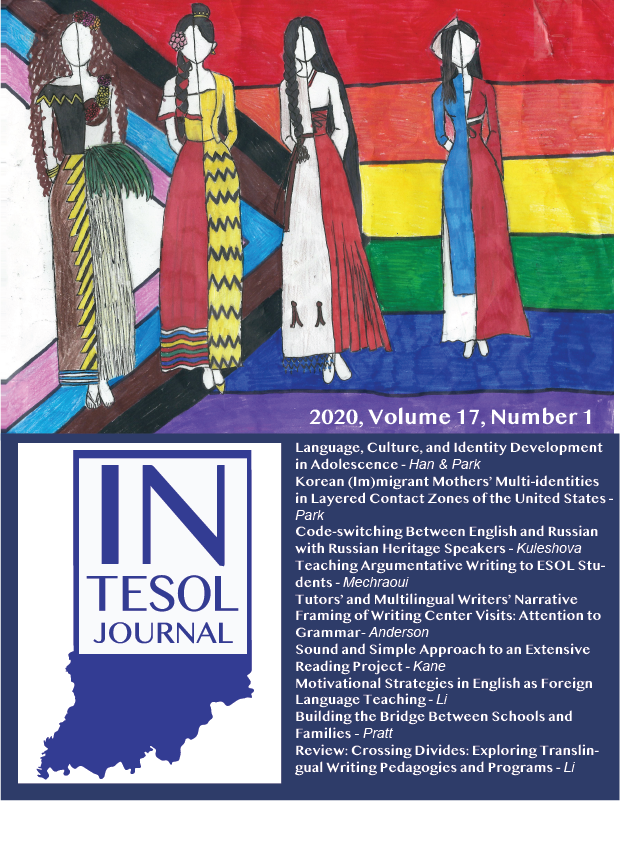Language, Culture, and Identity Development in Adolescence: A Case Study of a Sixteen-Year-Old Multilingual Boy
DOI:
https://doi.org/10.18060/24498Keywords:
identity, language minority, adolescence, heritage languageAbstract
A language learner has a complex social identity, which should be understood in a larger social context and interactions. The current study aimed to investigate the relationship between language and identity development through narrative inquiry. The participant of this case study is a sixteen-year-old Korean boy who speaks three languages and has been educated in the United States from kindergarten to high school. The results indicate that the child, who was exposed to multiple languages and raised by a family of immigrants, identifies himself in between different languages and cultures. Additionally, the linguistic and cultural identity of the participant was found to have influenced his heritage language maintenance. Finally, it was found that socio-cultural awareness of linguistic and cultural diversity impacted his multilingual competency during his adolescence.
References
Bucholtz, M., & Hall, K. (2004). Language and identity. A companion to linguistic anthropology, 1, 369-394. https://escholarship.org/uc/item/7198t0cr
Connelly, F. M., & Clandinin, D. J. (1990). Stories of experience and narrative inquiry. Educational researcher, 19(5), 2-14. https://doi.org/10.3102/0013189X019005002
Darvin, R., & Norton, B. (2016). Investment and language learning in the 21st century. Langage et société, (3), 19-38.
King, B. W. (2008). “Being gay guy, that is the advantage”: queer Korean language learning and identity construction. Journal of Language, Identity, and Education, 7(3-4), 230-252. https://doi.org/10.1080/15348450802237855
Lam, W. S. E. (2004). Second language socialization in a bilingual chat room: Global and local considerations. Language Learning & Technology, 8(3), 44-65.
McAdams, D. P., & McLean, K. C. (2013). Narrative identity. Current directions in psychological science, 22(3), 233-238. https://doi.org/10.1177/0963721413475622
McKay, S. L., & Wong, S. L. C. (1996). Multiple discourses, multiple identities: Investment and agency in second-language learning among Chinese adolescent immigrant students. Harvard educational review, 66(3), 577-609. https://doi.org/10.17763/haer.66.3.n47r06u264944865
Norton, B., & Toohey, K. (2011). Identity, language learning, and social change. Language teaching, 44(4), 412-446. https://doi.org/10.1017/S0261444811000309
Oriyama, K. (2010). Heritage Language Maintenance and Japanese Identity Formation: What Role Can Schooling and Ethnic Community Contact Play?. Heritage language journal, 7(2), 76-111.
Patton, M. Q. (2015). Qualitative Research & Evaluation Methods (4th ed.). Thousand Oaks, CA: SAGE.
Peirce, B. N. (1995). Social identity, investment, and language learning. TESOL quarterly, 29(1), 9-31.
Rojo, L. M. (2013). Capitalising students through linguistic practices: A comparative analysis of new educational programmes in a global era. Language, migration and social inequalities: a critical sociolinguistic perspective on institutions and work, Bristol, Multilingual Matters, 118-146.
Ushioda, E., & Dörnyei, Z. (2009). Motivation, language identities and the L2 self: A theoretical overview. Motivation, language identity and the L2 self, 2, 1-8.
Wiley, T.G., & Wright, W.E. (2004). Against the Undertow: Language-Minority Education Policy and Politics in the “Age of Accountability”. Educational Policy, 18(1), 142-168.
Downloads
Published
Issue
Section
License
Copyright (c) 2020 Jung Han

This work is licensed under a Creative Commons Attribution-NonCommercial 4.0 International License.


